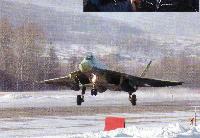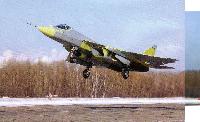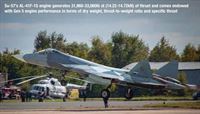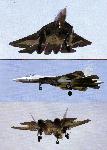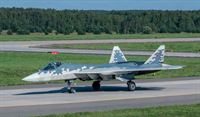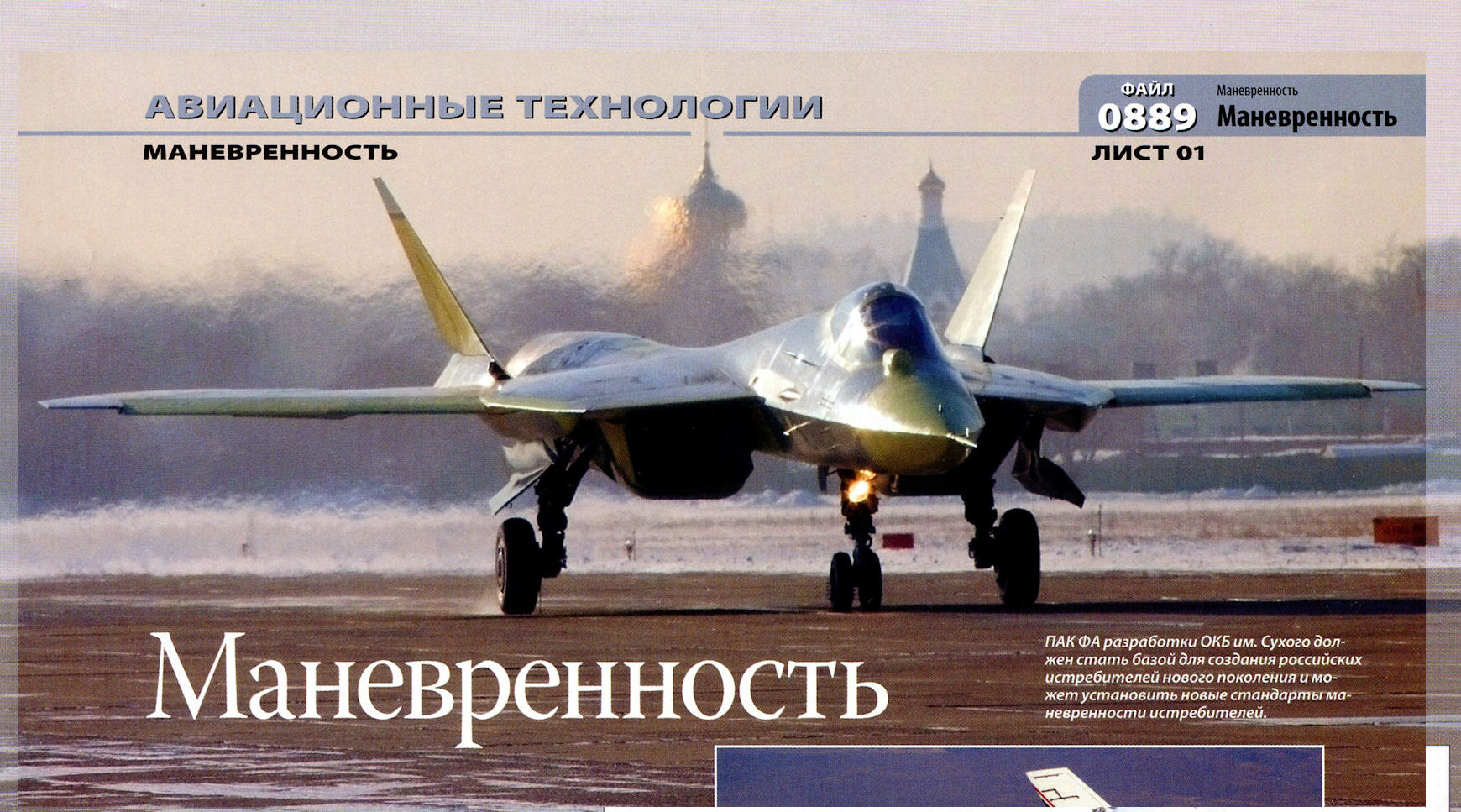
Т-50 (ПАК ФА)
Проходящий в настоящее время испытания самолет Т-50 является российским истребителем нового поколения. Предназначенный для замены истребителей МиГ-29 и Су-27, Т-50 создавался в рамках программы ПАК ФА (Перспективный авиационный комплекс Фронтовой Авиации).
При разработке Т-50 широко использовались решения, отработанные ОКБ Сухого при испытаниях экспериментального самолета Су-47. Т-50 выполнен по схеме с несущим корпусом. Кили являются цельноповоротными, также как и стабилизаторы. В конструкции планера широко используются композиционные материалы. Особенностями проекта являются малая радиолокационная заметность, сверхзвуковая крейсерская скорость и сверхманевренность, обеспечиваемая управлением вектором тяги.
Большая часть информации о ПАК ФА является секретной, но известно, что на нем будет установлено усовершенствованное бортовое оборудование, включая РЛС с активной фазированной антенной решеткой (АФАР). Вероятно, это будет РЛС Н050, являющаяся усовершенствованным вариантом РЛС "Ирбис-Е", используемой на Су-35.
Т-50 должен нести как ракеты класса "воздух-воздух" следующего поколения, так и ряд современных высокоточных боеприпасов "воздух-поверхность". Основное вооружение размещается в двух отсеках в фюзеляже, между воздухозаборниками, длиной около 5,0 м каждый. Небольшие ракеты, наподобие Р-73, размещаются в двух отсеках в корневой части крыла.
Пробежки первого Т-50 начались 24 декабря 2009 года, а первый полет состоялся 29 января 2010 года с аэропорта Дземги, принадлежащего КнААПО, где строился самолет. Второй Т-50 вышел на испытания в марте 2011 года. В том же году ПАК ФА был продемонстрирован на авиасалоне МАКС. Третий самолет, оснащенный РЛС с АФАР и системой управления огнем, совершил первый полет в августе 2012 года. Четвертый самолет поднялся в воздух 12 декабря 2012 году и в следующем месяце совершил перелет из Комсомольска-на-Амуре в подмосковный Жуковский, преодолев дистанцию свыше 6300 км.
Т-50 стал базой для создания индийского истребителя FGFA (Fifth-Generation Fighter Aircraft). Этот самолет будет совместно разрабатываться ОКБ Сухого и корпорацией HAL и будет отличаться системами, заданными индийской стороной. Россия и Индия в настоящее время планируют купить 60 и 144 самолета, соответственно. Выкатка первого FGFA запланирована на 2014 год, в то время как поступление Т-50 на вооружение российских ВВС ожидается в 2014-2015 годах.
ТАКТИКО-ТЕХНИЧЕСКИЕ ХАРАКТЕРИСТИКИ
Т-50
Тип: прототип одноместного истребителя
Силовая установка: два ТРДДФ АЛ-41Ф1 тягой 88,10 кН без и 153 кН на форсаже
Летные характеристики (оценочные): максимальная скорость на большой высоте 2200 км/ч; потолок 18 000 м; дальность полета 3300 кг
Масса: нормальная взлетная 25 670 кг; максимальная взлетная 34000 кг
Размеры: размах крыла 16,70 м; длина 22,60 м; высота 6,40 м; площадь крыла 56,0 м2
- Описание
Фотографии
-
Мировая Авиация 118
ПАК ФА разработки ОКБ им. Сухого должен стать базой для создания российских истребителей нового поколения и может установить новые стандарты маневренности истребителей.
-
Air International 2012-04 / P.Butowski - PAK FA /Military/
T-50-3 is the first aircraft to be fitted with the N036 AESA radar which forms part of the Sh121 electronic suite.
-
Air International 2011-02 / P.Butowski - Russian Supercruiser /Military/
Forward stretched wing-root extensions have large moving flaps on the leading edge, and are connected with the wings by elastic couplings.
-
Air International 2012-04 / P.Butowski - PAK FA /Military/
Sensors on the T-50-3: (1) radio transparent (dielectric) nose cone for the N036 radar; (2) 101KS-V infrared search and track; (3) 101KS-O electro-optical jammer; (4) 101KS-U warning sensor; (5) UV-50 decoy launchers.
-
Мировая Авиация 229
Первый полет нового российского малозаметного истребителя. 29 января 2010г.: на аэродроме КнААПО Дземги в Комсомольске-на-Амуре выполнил первый полет первый прототип истребителя 5-го поколения Т-50. Самолет разработан согласно требованиям ВВС РФ к перспективному авиационному комплексу фронтовой авиации ПАК-ФА, который должен превосходить американский F-22 Raptor. Летные испытания начались с запозданием, вызванным причинами технического характера. Первый полет продолжительностью 47 минут выполнил Герой России летчик-испытатель Сергей Богдан.
-
Air International 2012-01 / News
Sukhoi test pilot Sergey Bogdan completed the maiden flight of Sukhoi T-50-3 on November 22, 2011 from Komsomolsk-on-Amur in Khabarovsk Krai, Russia. The aircraft is the third flying prototype of the fifth generation multi-role fighter and spent just over one hour in the air. It is the first example equipped with the Tikhomirov Scientific Research Institute of Instrument Design active phased-antenna array radar and lacks the nose-mounted pitot tube of the first two. A batch of 16 Ufa Motor Building Production Association 117S engines for the T-50 has been completed, according to an announcement by the engine manufacturer on November 24. Six will be used for static tests and others fitted to T-50s.
-
Air International 2011-04 / News
3 марта 2011г. в Комсомольске-на-Амуре состоялся первый полет второго опытного экземпляра ПАК ФА (перспективного авиационного комплекса фронтовой авиации). Самолет пилотировал заслуженный летчик-испытатель Российской Федерации Сергей Богдан. Машина провела в воздухе 44 минуты и совершила посадку на заводском аэродроме. В ходе полета была проведена проверка устойчивости самолета, оценка работы систем силовой установки. Сегодня по программе ПАК ФА полностью завершен комплекс предварительных наземных и летных работ, в которых задействованы три опытных образца (два летных и один для статиспытаний). Первый вылет ПАК ФА состоялся 29 января 2010 г. в Комсомольске-на-Амуре. На сегодня на этом самолете совершено 36 полетов.
The second Sukhoi T-50 (T-50-2) is seen lifting off for it maiden flight at Komsomolsk-on-Amur on March 3, 2011. It displays subtle differences from T-50-1. -
Air International 2011-02 / P.Butowski - Russian Supercruiser /Military/
T-50-1 on final approach to Komsomolsk-on-Amur. The right side oblong under wing fairing is easily seen, near the fuselage.
-
Air International 2011-02 / P.Butowski - Russian Supercruiser /Military/
The T-50's tandem internal weapon bays can clearly be seen under the fuselage extending from a forward point adjacent the engine inlets to the engine nozzles.
-
Air International 2011-02 / P.Butowski - Russian Supercruiser /Military/
T-50-1 on its maiden flight from Komsomolsk-on-Amur plant on January 29, 2009.
-
История Авиации 34 / ??? - Прототип ПАК ФА - в воздухе! /Когда верстался номер/
Первый полет успешно завершен
-
Air International 2011-02 / P.Butowski - Russian Supercruiser /Military/
Two drag chutes help to slow T-50-1 on roll-out after landing on the runway at Komsomolsk-on-Amur following the type's maiden flight on January 29, 2009.
-
Air International 2011-04 / News
The second Sukhoi T-50 (T-50-2) is seen landing after it maiden flight at Komsomolsk-on-Amur on March 3, 2011.
-
Авиация и Космонавтика 2013-10 / А.Юргенсон - МАКС-2013
Тройка Т-50 на старте
-
Air International 2014-07 / P.Butowski - Orions, Pirates & Hunters /Military/
T-50-3 in the foreground, with T-50-4 behind.
-
Air International 2021-10 / A.Mladenov - After the burn
Su-57's AL-41F-1S engine generates 31,960-33,060lb st (14.22-14.72kN) of thrust and comes endowed with Gen 5 engine performance in terms of dry weight, thrust-to-weight ratio and specific thrust
-
Air International 2011-02 / P.Butowski - Russian Supercruiser /Military/
PAK FA prototype T-50-1 makes a spirited departure from the runway at Zhukovsky.
-
Air International 2012-10 / News
PAK FA T-50-2 takes-off from Zhukovsky airfield.
-
Air International 2012-10 / News
Measuring lines painted over the nose of T-50-2 for the video analysis of air-refuelling.
-
Air International 2011-02 / P.Butowski - Russian Supercruiser /Military/
The main landing gear in the final moment of the retraction sequence.
-
Air International 2012-10 / News
T-50-3 is the first PAK FA prototype fitted with the N036 radar. Since late July 2012, the aircraft has undertaken flight trials using Su-27M Flanker 710 as a target. The three short lines on the radar cone are the trestle tracks used when the radome is removed from the aircraft.
-
Авиация и Время 2010-02 / А.Совенко - Отродясь такого дива не видали на Руси...
Опытный истребитель Т50-1 уходит в свой второй полет уже в окраске боевой машины. 12 февраля 2010г.
-
Авиация и Космонавтика 2013-02
17 января 2013 г. четвертый летный образец перспективного авиационного комплекса пятого поколения Т-50 прибыл на аэродром Летно-исследовательского института им М.М. Громова в подмосковном Жуковском. Самолет впервые совершил длительный перелет с авиационного завода в Комсомольске-на-Амуре, совершив промежуточные посадки. Пилотировал Т-50 заслуженный летчик-испытатель Российской Федерации Герой России Сергей Богдан.
-
Air International 2011-10 / P.Butowski - MAKS-2011
A streamline angle of the T-50;
-
Air International 2011-10 / P.Butowski - Sukhoi's T-50 on Show /Military/
Sukhoi T-50 at MAKS 2011.
-
Air International 2015-06 / P.Butowski - Standstill or Respite? /Military/
Su-57 prototype T50-3 loaded with R-73 and R-77 air-to-air missiles on underwing pylons. The long-range R-77M version features a multifunction doppler monopulse active radar seeker, strakes fitted at the mid-fuselage position, conventional fins at the tail, and a dual pulse rocket motor.
T-50-3 carrying dummy R-77 and R-73 missiles in the Aviadarts demonstration. This aircraft, as well as T-50-4 and T-50-5, is equipped with N036 AESA radar in basic configuration with single forward antenna only. -
Air International 2018-03 / News by countries
Prototype Su-57, T-50-4, seen in 2014 loaded with two Kh-31 and two R-77-1 inert missile rounds on the underwing pylons used for aerodynamic carriage trials.
-
Air International 2015-06 / P.Butowski - Standstill or Respite? /Military/
The fourth prototype, T-50-4, carrying dummy versions of air-to-ground Kh-31s and air-to-air R-77s - the Sukhoi T-50 has yet to fire missiles. The basic ordnance load is carried in two large weapon bays in tandem inside the fuselage while close-air combat missiles fit in two small underwing fairings close to the engines' inlets.
-
Air International 2013-10 / P.Butowski - Maxing Out at MAKS /Military/
Sergey Bogdan pulls T-50 052 into inverted flight during his flight demonstration routine at Zhukovsky.
-
Air International 2014-01 / P.Butowski - Russia's Vision 2025 /Military/
Sixty Sukhoi T-50 PAK FAs should be in service with the RuAF by 2020.
-
Air International 2018-06 / A.Mladenov - Russian Bears sharpen their claws /Military/
Production of the Su-57 is expected to begin in 2018, with the first two examples being delivered to the RuASF for so-called experimental operation and field trials in late 2019. Currently, there are ten T-50 prototypes involved in the exhaustive test and evaluation effort.
-
Air International 2011-02 / P.Butowski - Russian Supercruiser /Military/
Sukhoi's T-50 in the climb.
-
Мировая Авиация 244
Т-50 продолжает российскую традицию создания самолетов с великолепной аэродинамикой. Большое число рулевых поверхностей в сочетании с управлением вектором тяги, вероятно, делают Т-50 самым маневренным истребителем в мире. Поворотные части корневых наплывов работают подобно ПГО.
-
Air International 2011-02 / P.Butowski - Russian Supercruiser /Military/
Good rear view shot of T-50-1.
-
Air International 2015-06 / P.Butowski - Standstill or Respite? /Military/
T-50-2 has no radar and features a long pitot tube at the nose tip. Along with T-50-1, it is used for performance and handling tests.
-
Air International 2015-08 / P.Butowski - Russian Fighter Showcase /Military/
T-50 PAK FA, side number 054, carrying two R-77 air-to-air missiles.
-
Air International 2013-10 / P.Butowski - Maxing Out at MAKS /Military/
Sergey Bogdan performs the Cobra manoeuvre in T-50 052 at MAKS 2013.
-
Air International 2017-09 / P.Butowski - Enter the Su-57 /Military/
After successful completion of the first stage of T-50 testing, a preliminary conclusion of the test programme was signed at MAKS 2017. The state commission recommended production of an initial batch of aircraft which are to be assigned the new Su-57 designation.
-
Air International 2019-09
Sergey Bogdan and Sergey Chernyshev flew a demonstration which included aerobatics and an air-to-air engagement. The demonstration was notable though not that dynamic due to flight envelope restrictions. Both aircraft, T-50-2 and T-50-4, are prototypes built without the current upgrade.
-
Air International 2018-08 / News by countries
The Su-57 was combat-tested in Syria, with a limited scope to evaluate the aircraft's integration within the common Russian command-and-control system.
-
Авиация и Время 2011-05 / Р.Мараев - МАКСа разноцветье
Опытные истребители T-50
-
Air International 2011-10 / P.Butowski - MAKS-2011
Both of the Sukhoi T-50s currently participating in the type's flight test programme took part in the daily flying display which included a formation flypast.
-
Air International 2013-10 / P.Butowski - Maxing Out at MAKS /Military/
T-50 pilots Sergey Bogdan, Roman Kondratyev and Sergey Cherneyshev performed a graceful three-ship display at MAKS 2013.
-
Air International 2015-06 / P.Butowski - Standstill or Respite? /Military/
During more than five years of trials, the T-50 prototypes have made about 600 flights, a sixth of those necessary for testing the fighter.
-
Авиация и Время 2013-05 / А.Совенко - МАКС-2013 в цифрах и фактах
Показательный полет тройки истребителей Т-50
-
Авиация и Космонавтика 2012-09 / В.Бакурский - Праздник в воздухе
Другие самолёты на фотографии: МиГ МиГ-35 / МиГ-29М2 / МиГ-29MRCA - Россия - 2002
-
Авиация и Космонавтика 2015-06 / М.Никольский - МиГ-35. Второе дыхание
МиГ-29М2 (МиГ-35) в совместном полете с перспективным истребителем Т-50 на авиашоу в честь 100-летия ВВС России, 2012 г.
Другие самолёты на фотографии: МиГ МиГ-35 / МиГ-29М2 / МиГ-29MRCA - Россия - 2002
-
Авиация и Космонавтика 2014-01 / М.Никольский - Шаг в 2020 год /Обзор/
Другие самолёты на фотографии: МиГ МиГ-35 / МиГ-29М2 / МиГ-29MRCA - Россия - 2002
-
Авиация и Космонавтика 2012-09 / В.Бакурский - Праздник в воздухе
Другие самолёты на фотографии: МиГ МиГ-35 / МиГ-29М2 / МиГ-29MRCA - Россия - 2002
-
Air International 2012-10 / News
T-50-2 in formation with a MiG-29M2 fighter during the airshow held on August 10-12, 2012 at Zhukovsky to celebrate the 100th anniversary of the Russian Air Force.
-
Авиация и Космонавтика 2015-11 / А.Юргенсон - Сюрпризы МАКС-2015
В полете Су-34 и Т-50
Другие самолёты на фотографии: Сухой Су-34 / Су-32 / Су-27ИБ - Россия - 1990
-
Air International 2019-02 / P.Butowski - Su-57 slowed down? /Military/
Still frames from an official Russian Ministry of Defence video showing a Su-57 launching a Kh-59MK2 stand-off missile.
-
Air International 2014-04 / News
Sukhoi T-50-2 recently arrived at Akhtubinsk to begin state trials of the aircraft.
-
Авиация и Космонавтика 2018-04
Самолет Су-57 с вооружением, размещенным на внешних узлах подвески
-
Авиация и Космонавтика 2010-06
В ЛИИ им. М.Громова продолжаются летные испытания перспективного истребителя ПАК ФА, созданного в ОАО "Компания "Сухой""
-
Air International 2011-02 / P.Butowski - Russian Supercruiser /Military/
A good view of the form of the upper fuselage and the forward form of the wing.
-
Air International 2011-02 / P.Butowski - Russian Supercruiser /Military/
Seconds from touch down at Zhukovsky, this view of the T-50-1 shows the small single piece vertical tail surfaces set at an obtuse angle of 26°.
-
Air International 2017-09 / P.Butowski - Enter the Su-57 /Military/
T-50-2 landing at Zhukovsky showing some of the modifications made to the aircraft during the first stage of testing. The main undercarriage doors are re-shaped and the fairing of the electronic countermeasures antenna located between the engines nozzles is new.
-
Авиация и Космонавтика 2018-04
Самолет Су-57 с вооружением, размещенным на внешних узлах подвески
-
Air International 2011-02 / P.Butowski - Russian Supercruiser /Military/
A test pilot climbs into the cockpit of T-50-1 at Zhukovsky on June 17 for a demonstration flight for the Prime Minister of Russia Vladimir Putin.
-
Авиация и Время 2012-04
10-12 августа 2012г. в подмосковном Жуковском на аэродроме Раменское состоялось крупное авиашоу, посвященное 100-летию ВВС России. На фото: самолеты-символы разных поколений - полномасштабная летающая копия И-15бис и суперсовременный истребитель T-50
Другие самолёты на фотографии: Поликарпов И-15бис / И-152 - Россия - 1937
-
Air International 2013-10 / P.Butowski - Maxing Out at MAKS /Military/
T-50s 051, 052 and 054 ready for take-off at Zhukovsky. MAKS 2013 was the first time that three T-50 aircraft had flown together in a public display.
-
Air International 2015-06 / P.Butowski - Standstill or Respite? /Military/
T-50-5 is under repair after sustaining serious damage in a fire on June 10, 2014.
-
Авиация и Космонавтика 2017-11
Истребитель с заводским индексом Т-50, создаваемый по программе ПАК ФА, получил официальное обозначение Су-57
-
Air International 2020-12 / P.Butowski - Lighter Il-112V ready to fly again /Russian Review/
This shot from the video shows the Su-57 ‘058’ in a test flight with the cockpit’s canopy removed
-
Air International 2019-02 / P.Butowski - Su-57 slowed down? /Military/
This landing shot of prototype Su-57, T-50-8, shows how slender the main fuselage is.
-
Air International 2014-01 / News
Sukhoi T-50-5 ‘055’ blue arriving at Zhukovsky on November 20, 2013, after arriving from Komsomolsk-on-Amur.
-
Авиация и Космонавтика 2021-07 / С.Александров, А.Бельтюков, А.Ерешко, А.Мартынов - Воздушный парад над Москвой
Су-57 участник парада Победы
-
Авиация и Космонавтика 2016-01
Пятый опытный истребитель Т-50 вновь подключается к программе летных испытаний
-
Авиация и Космонавтика 2025-03
Новейший истребитель пятого поколения Су-57Э впервые демонстрировался на международном авиасалоне Aero India 2025. Международная авиационно-космическая выставка и авиасалон «Aero India» проводится с 1996 года на территории военно-воздушной базы ВВС «Елаханка». В 2025 году уже 15 по счету выставка проходила с 10 по 14 февраля. Мероприятие имеет статус одной из ведущих выставок авиационно-космической отрасли в Юго-Восточной Азии.
-
Air International 2020-08 / P.Butowski - Russian aviation in the time of COVID-19 /Russian Review/
The Su-57's shadow fuselage form is clearly shown in this shot of aircraft T-50-1.
On June 27 last year, the Russian defence ministry placed a contract for 76 new-generation Su-57 fighters. The first serial-production fighter crashed on December 24, 2019, just before planned delivery. -
Air International 2019-10 / P.Butowski - Russian fifth-gen /Military/
Su-57 T-50-1 051 photographed in perfect light to show the pixelated camouflage scheme.
-
Авиация и Космонавтика 2018-06
Воздушный парад над Москвой 9 мая 2018г.
-
Air International 2019-02 / P.Butowski - Su-57 slowed down? /Military/
Prototype Su-57, T-50-5, side number 055 painted with the latest camouflage scheme, seen in the spring of 2018.
Perhaps the most promising Russian military aircraft, the Sukhoi Su-57, is accomplishing testing and entering serial production in its initial version. In the middle of this decade, a modernised version will be created powered by new-generation engines. -
Авиация и Космонавтика 2023-08 / В.Бакурский - Новые реалии войны в воздухе
Совместный полет БПЛА «Охотник» и истребителя Су-57
Другие самолёты на фотографии: Сухой С-70 Охотник - Россия - 2019
-
Авиация и Космонавтика 2024-02 / М.Никольский - "Верный ведомый". Или уже "ведущий"?
Совместный полет БПЛА С-70 «Охотник» и истребителя Су-57
Другие самолёты на фотографии: Сухой С-70 Охотник - Россия - 2019
-
Air International 2020-08 / P.Butowski - Russian aviation in the time of COVID-19 /Russian Review/
The Su-57 holds great potential for the future of Russian military aviation.
-
Air International 2020-10 / P.Butowski - Russia seeks to double output
Su-57 fighters flying in formation
-
Air International 2019-10 / P.Butowski - Russian fifth-gen /Military/
Su-57 T-50-3 currently features a pixelated silhouette of an S-70 Okhotnik unmanned combat air vehicle on its underside. The S-70 is being developed specifically for joint operations with the Su-57 as a wingman.
-
Air International 2019-02 / P.Butowski - Su-57 slowed down? /Military/
A close-up shot of the forward fuselage of Su-57 prototype T-50-11, side number 511, equipped with a production standard sensor suite.
-
Air International 2019-10 / P.Butowski - Russian fifth-gen /Military/
Su-57 T-50-5R 055 landing at Zhukovsky.
-
Air International 2019-10 / Airscene
Two shots of Su-57 T-50-4 performing a short landing with the brake chute deployed before touchdown.
-
Air International 2021-10 / A.Mladenov - After the burn
The Su-57 features a deep integration of the engine control system and the aircraft’s flight control system, through use of the integrated flight and propulsion control concept, to provide performance gains
-
Авиация и Космонавтика 2021-09 / А.Юргенсон - Новинки МАКС-2021 (1)
Другие самолёты на фотографии: Иркут, ОКБ Яковлева МС-21 - Россия - 2017
-
Air International 2019-10 / P.Butowski - Russian fifth-gen /Military/
It remains unknown whether the prototype Su-57s feature low-observable coatings like those applied to the type's American fifth-generation cousins. The camouflage scheme and variety of paints seen on aircraft T-50-5R 055 suggest not.
-
Air International 2019-02 / P.Butowski - Su-57 slowed down? /Military/
Su-57 T-50-9 was one of two deployed to Syria in February 2018; the aircraft is seen taxying at Hmeimim Air Base without corner reflectors fitted.
-
Авиация и Космонавтика 2021-07 / С.Александров, А.Бельтюков, А.Ерешко, А.Мартынов - Воздушный парад над Москвой
Су-57 участник парада Победы
-
Air International 2019-02 / P.Butowski - Su-57 slowed down? /Military/
A part-pixel camouflage scheme applied to T-50-9, side number 509, seen at Zhukovsky.
-
Air International 2017-09 / P.Butowski - Enter the Su-57 /Military/
T-50-9 509 was supposed to be shown to Vladimir Putin in a separate, closed pavilion, painted in similar large pixels. The type’s new Su-57 designation was supposed to be officially announced there, but the ceremony did not take place.
-
Авиация и Космонавтика 2021-07 / С.Александров, А.Бельтюков, А.Ерешко, А.Мартынов - Воздушный парад над Москвой
Су-57 участник парада Победы
-
Air International 2011-02 / P.Butowski - Russian Supercruiser /Military/
Putin views his latest mount.
-
Авиация и Космонавтика 2019-08 / М.Дворников, Ю.Воловик - Летчик, помни! Коварные факторы полета (1)
Президент России B.B. Путин и лётчик-испытатель С.Л. Богдан у самолёта Т-50
-
Air International 2019-10 / Airscene
Putin and Erdogan discuss Sukhoi's Su-57 at MAKS 2019.
-
Air International 2018-01 / Airscene
A close-up shot of the engine nozzles of a isdeliye 30 engine installed on the left and a standard (slightly longer) AL-41F1 (isdeliye 117) engine on the right on the second prototype Su-57 fighter T-50-2 during a 17-minute flight flown by Sukhoi's chief test Sergey Bogdan on December 5, 2017.
-
Air International 2019-12 / News by countries
The first production-series Su-57 Felon, 51001 (01 blue) on the production line at Komsomolsk-on-Amur.
-
Air International 2020-10 / P.Butowski - Russia seeks to double output
A Su-57 in final assembly at KnAAZ, August 12, 2020
-
Air International 2011-10 / P.Butowski - Sukhoi's T-50 on Show /Military/
The 101KS-V sensor can simultaneously detect, identify and track multiple airborne targets and is fitted in a turret mounted on the starboard side of the forward fuselage in front of the cockpit.
-
Air International 2013-10 / P.Butowski - Maxing Out at MAKS /Military/
Two versions of the PAK FA's ultraviolet missile approach warning sensor were displayed at MAKS 2013: the single-window 101KS-U/01 (left) and on its public debut the twin-window 101KS-U/02 (right).
-
Air International 2011-10 / P.Butowski - Sukhoi's T-50 on Show /Military/
The smaller of the two 101KS-U sensors
-
Air International 2011-10 / P.Butowski - Sukhoi's T-50 on Show /Military/
The 101KS-O sensor is a laser-based directional countermeasure for heat-seeking missiles fitted in a turret on the upper fuselage spine aft of the cockpit.
-
Air International 2015-06 / P.Butowski - Standstill or Respite? /Military/
The purpose of one of the 101KS Atoll electro-optical sensors, the 101KS-O, is unclear. It is presented by the Russians as an infrared jammer for self-defence, but is probably an infrared search-and-track sight.
-
Air International 2011-02 / P.Butowski - Russian Supercruiser /Military/
Yuri Belyi, head of the NIIP radar design bureau (right) and Anatoly Sinani, head of the antenna division at NIIP together with the first test example of a front AESA antenna for the Sh 121 radar system.
-
Air International 2015-06 / P.Butowski - Standstill or Respite? /Military/
The N036-01-1 forward-looking X-band electronic-scanning antenna comprises 1,552 transceiver modules and is tilted about 15 degrees up.
-
Air International 2011-10 / P.Butowski - Sukhoi's T-50 on Show /Military/
The Tikhomirov NIIP Institute displayed the N036-01-1 active electronic scanning antenna of the T-50's forward X-band N036 radar.
-
Air International 2013-10 / P.Butowski - Maxing Out at MAKS /Military/
On display at this year's show was the N036 radar's side-mounted X-band electronically scanned array antenna.
-
Air International 2011-10 / P.Butowski - Sukhoi's T-50 on Show /Military/
Another shot of the T-50's targeting pod.
-
Air International 2011-10 / P.Butowski - Sukhoi's T-50 on Show /Military/
The Atoll system also has the 101KS-N sensor installed in a targeting pod which is carried on the underside of the T-50's engine air intake. The sensor can detect, identify and track ground targets.
-
Air International 2013-10 / P.Butowski - Maxing Out at MAKS /Military/
The 250kg KAB-250 precision guided-bomb has been specifically designed for the T-50 PAK FA.
-
Air International 2011-10 / P.Butowski - Sukhoi's T-50 on Show /Military/
KAB-250 is a 250kg (550lb) precision-guided missile that measures 3.2m in length, the missile fuselage has a 255mm diameter and a 550mm fin span. The missile is carried in the T-50's weapons bay on a UVKU-50L ejection launcher.
-
Air International 2011-02 / P.Butowski - Russian Supercruiser /Military/
The Raduga missile design bureau miniaturized its Kh-58 anti-radar missile (above) into the Kh-58UShK version (below) to fit inside the PAK FA's internal bay.
-
Air International 2018-03 / News by countries
The Kh-58UShKE and the Kh-31AD will take a prominent place in the Su-57's arsenal. The Kh-31D is an anti-ship missile capable of flying at Mach 3.
-
Air International 2011-02 / P.Butowski - Russian Supercruiser /Military/
The maximum size of weapon to be carried inside the weapon bays is 4,200 x 400 x 400mm (165 x 16 x 16 inches) and these are the exact dimensions of the new modular Kh-38M air-to-ground missile with folded wings and fins. Several seekers are available for the Kh-38M including semi-active laser, active radar, and infrared as well as a satellite navigation receiver. A Kh-38M weighs up to 520kg (235lb) including a 250kg (114lb) warhead. The missile's maximum range is 40km (25 miles).
-
Air International 2018-08 / News by countries
The Kh-59MK2 missile incorporates low-observable features and folding wings for internal carriage by the Su-57.
-
Air International 2011-10 / P.Butowski - Sukhoi's T-50 on Show /Military/
Some of the T-50's life support systems; the NPP Zvezda K36D-5 ejection seat, and the SOZhE-50 life support system, including the PPK-7 pilot suit and ZSh-10 helmet.
-
Авиация и Время 2010-02 / А.Совенко - Отродясь такого дива не видали на Руси...
Подготовка к очередному испытательному полету
-
Авиация и Время 2010-02 / А.Совенко - Отродясь такого дива не видали на Руси...
Истребители Су-35УБ и Т50-1 на стоянке КнААПО. Разница очевидна
Другие самолёты на фотографии: Сухой Су-30 - Россия - 1988
-
Авиация и Время 2013-01
18 января 2013г. из Комсомольска-на-Амуре на аэродром ЛИИ им. М.М. Громова в подмосковном Жуковском прибыл четвертый летный образец истребителя ПАК-ФА (Т-50). Пилотировал самолет летчик-испытатель Сергей Богдан. Первый вылет Т-50-4 состоялся в Комсомольске-на-Амуре на аэродроме Дземги 12 декабря 2012 г. Т-50-4 присоединится к программе летных испытаний ПАК ФА, в которой пока были задействованы три машины, совершившие уже более 200 полетов.
-
Авиация и Время 2011-06
22 ноября 2011г. в Комсомольске-на-Амуре состоялся первый полет самолета Т-50-3 - третьего опытного образца авиационного комплекса пятого поколения ПАК ФА. Его пилотировал заслуженный летчик-испытатель Сергей Богдан. Полет продолжительностью более часа прошел успешно. Т-50-3 стал важным этапом в развитии программы ПАК ФА, т.к на нем будет установлен весь комплекс бортового радиоэлектронного оборудования.
-
Авиация и Космонавтика 2011-11 / В.Ильин - Российские тактические боевые самолеты на авиасалоне МАКС-2011 и их оценка мировыми СМИ
Пара опытных T-50 в воздухе над авиасалоном
-
Авиация и Космонавтика 2012-09 / В.Бакурский - Праздник в воздухе
ПАК ФА в сопровождении МиГ-35
Другие самолёты на фотографии: МиГ МиГ-35 / МиГ-29М2 / МиГ-29MRCA - Россия - 2002
-
Авиация и Космонавтика 2011-09 / А.Юргенсон - Юбилейный МАКС-2011
Оптические системы T-50 на стенде УОМЗ
-
Air International 2020-12 / P.Butowski - Lighter Il-112V ready to fly again /Russian Review/
The Su-57’s cockpit features two large MFI-50 displays, small MFPI-50 display and control panel, and a ShKAI-50 head-up display
-
Air International 2011-02 / P.Butowski - Russian Supercruiser /Military/
Computer-generated image of the PAK FA's cockpit.
-
Air International 2020-06 / P.Butowski - Russian Review
An early model of the Sukhoi T-50 new-generation fighter - now known as the Su-57 - used to test control surfaces in TsAGI's T-112 wind tunnel.
-
Авиация и Космонавтика 2013-04 / И.Кудишин - "Аэроиндия-2013"
Модель перспективного многоцелевого истребителя для ВВС Индии
-
Air International 2015-06 / P.Butowski - Standstill or Respite? /Military/
A model of the Prospective Multi-role Fighter, or Type 79L, to be developed jointly by Russia and India.
-
Авиация и Космонавтика 2015-07 / М.Никольский - Авиационные программы Индии (3)
Модель истребителя, разрабатываемого по программе FGFA
-
Air International 2011-02 / P.Butowski - Russian Supercruiser /Military/
A drawing from Vympel of the UVKU (Unifitsirovannoye Vnutrifyuzelazhnoye Katapultnoye Ustroystvo) unified internal catapult launcher.
-
Air International 2017-09 / P.Butowski - Enter the Su-57 /Military/
Su-57 final sensor suite configuration
-
Air International 2019-02 / P.Butowski - Su-57 slowed down? /Military/
The author's graphic showing the location of the Su-57's various sensors.
-
Air International 2011-10 / P.Butowski - Sukhoi's T-50 on Show /Military/
Atoll also includes two ultraviolet sensors each designated 101 KS-U, one being larger than the other.
-
Air International 2012-04 / P.Butowski - PAK FA /Military/
A PAK FA drawing from the patent documentation.
In late January the Russian patent office published the patent (submitted on July 28, 2010) of the T-50 configuration, which confirms previous speculation about the fighter. The aircraft features (all shown on the diagram) a blended-body aerodynamic configuration with a lift-generating fuselage (1), fuselage extensions (2) and wing outer sections (3). The empennage, both horizontal (4) and vertical (5) is all-moving and can be deflected together or differentially. The vertical fins rotate differentially and act as an air brake. The engines are housed in wide-spaced nacelles (6) and the axes of the engines are splayed outwards. The engine nozzles (14) can be deflected together or differentially. The wing high-lift devices comprise leading-edge flaps (9), ailerons (10) and flaperons (11).
Other control surfaces include movable front elements of the leading-edge extensions (8), under which engine air intakes (7) are positioned. The patent lists the extensions as 'fuselage' and not 'wing' leading-edge extensions. All-moving vertical fins are mounted on 'stub-pylons' (12) in front of which the air intakes (13) for engine bay cooling and the air-conditioning systems are situated. -
Air International 2011-02 / P.Butowski - Russian Supercruiser /Military/
1. NIIP Sh121 radar system will have five active electronic-scanning aerials including a forward-looking X-band aerial in the nose. 2. Most probably, this plate covers side-looking X-band radar of the Sh121 system. 3. L-band radar antenna in the front part of wing's nose flap. 4. Forward looking electro-optical sight. 5. Upper-hemisphere EO device. 6. Long tail beam protruding between the engines nozzles contains two brake chutes. Sukhoi designers insist that no rear-looking radar is planned for the PAK FA. 7. Huge wing root extension with large leading-edge flaps connected with the wings by elastic couplings. 8. Small all-moving tailfins are deflected by 26° aside. 9. All-moving tail planes (as well as tailfins) are fitted to large carrying beams. 10. Two-section flaperon. 11. Single-barrel 30mm cannon. 12. Flight refuelling probe. 13. Each of these two large weapon bays inside the fuselage could fit two large air-to-air or air-to-surface missiles; note 'stealth' tooth-shaped doors of these compartments as well as the landing gear compartment in front. 14. 'Quick bay' for single close-air combat air-to-air missile. 15. Fittings for weapon/stores pylons, two under each wing. 16. These are empty places on the T-50-1 prototype but probably chaff and flare dispensers will be located here in the future. 17. Two Saturn AL-41F1 (117) thrust-vectoring turbofans rated at 15 tons (147kN/33,046lb) each
-
Авиация и Время 2010-02 / А.Совенко - Отродясь такого дива не видали на Руси...
Опытный самолет Т50-1
Тип фотографий
- Все фото (219)
- Цветные фото (194)
- Ч/б фото (11)
- Кабина (2)
- Модели, схемы (12)





